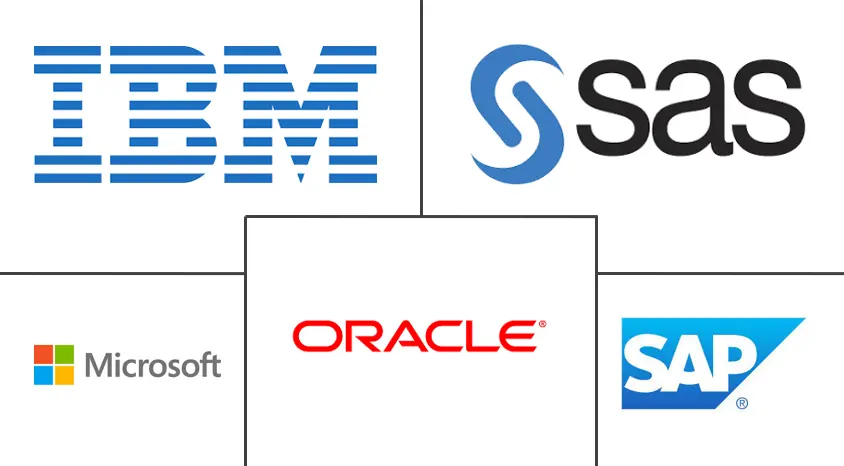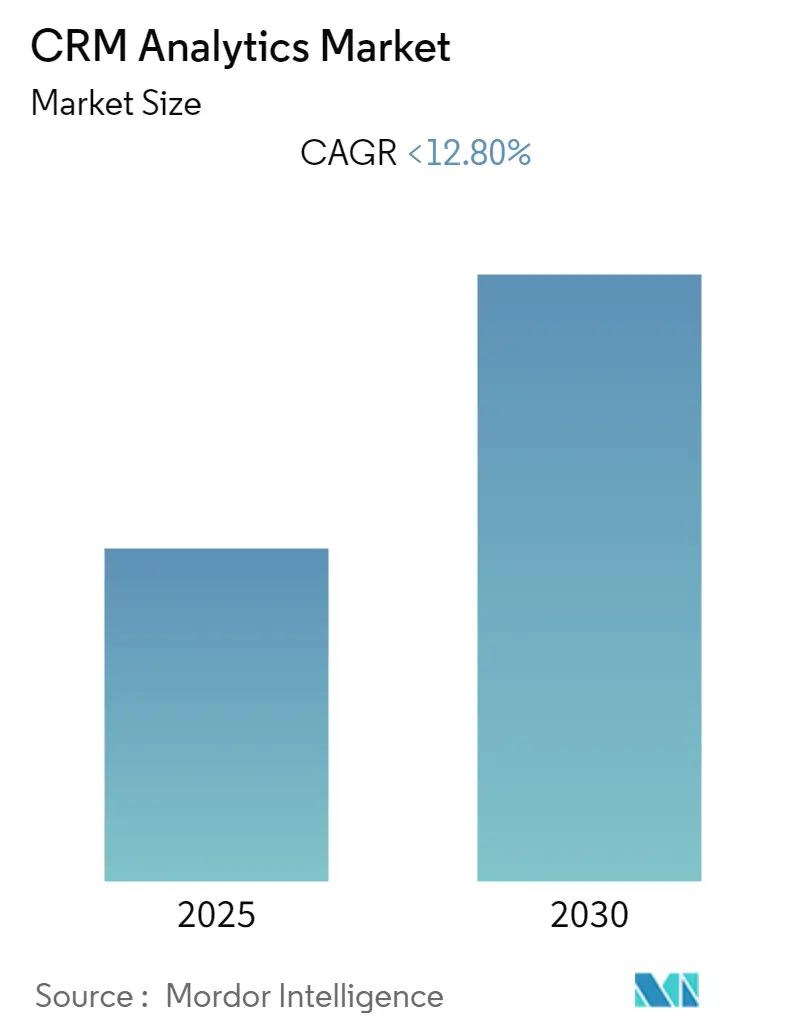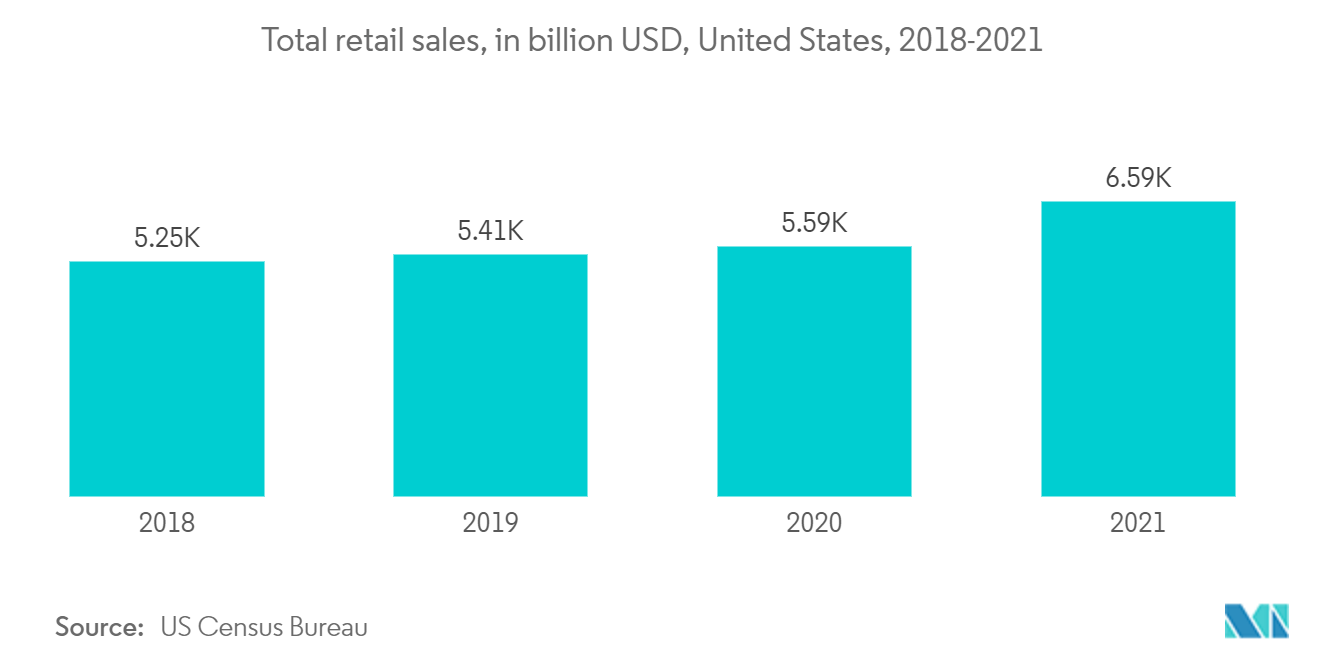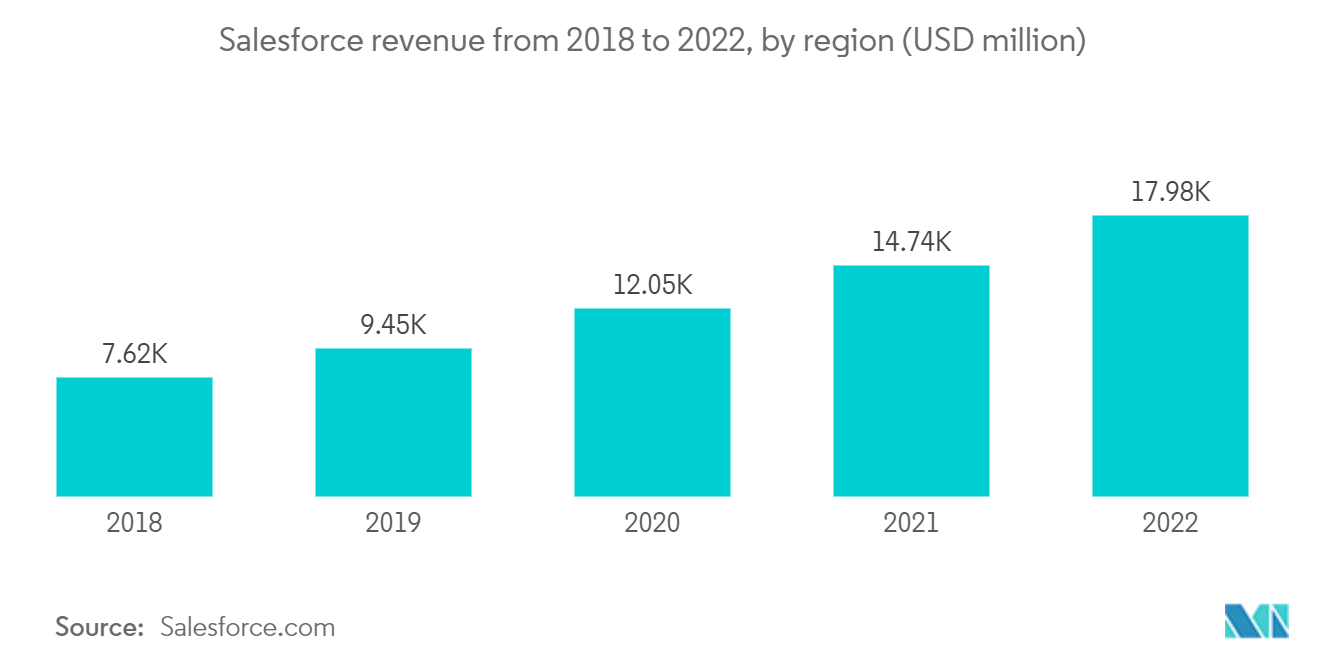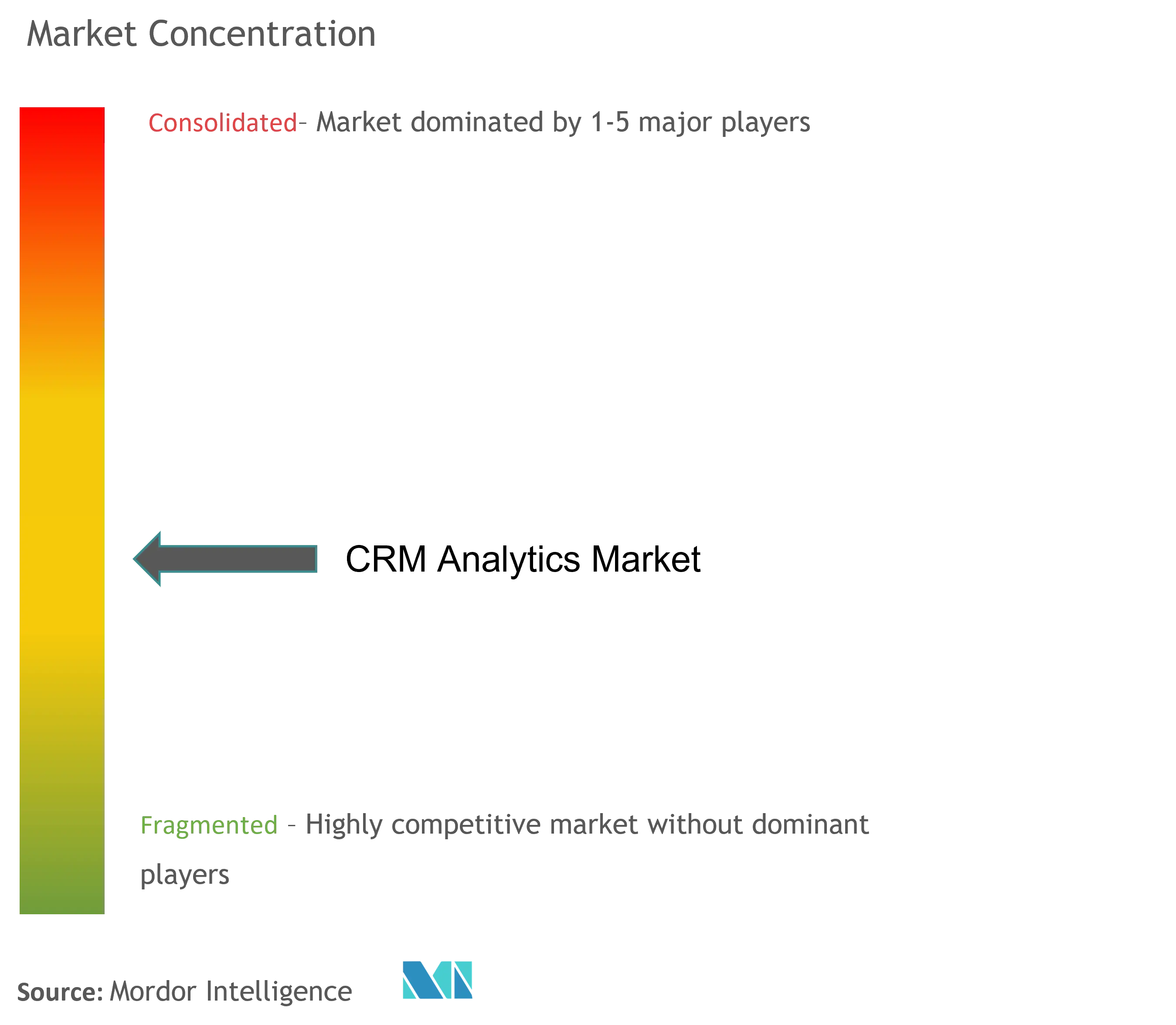CRM Analytics Market Analysis
The CRM Analytics Market is expected to register a CAGR of less than 12.8% during the forecast period.
- CRM analytics refers to the process of uncovering valuable insights about customers that businesses can act upon from the data that resides in the CRM database. Integration with analytics makes CRM systems more intelligent at comprehending customers and empowers consumers to make data-driven decisions.
- A company's sales team has traditionally managed lead management using customer relationship management (CRM) and data from all human interactions (calls, direct mail, and other marketing tools).CRM has become a necessity for enterprises of all sizes, similar to the role played by the ERP system in managing supply chain activities.
- Further advancements have been announced in the CRM analytics market, such as leveraging speech analytics tools for analyzing the vast amounts of unstructured information pouring into a contact center, which has the potential to evaluate everything from call compliance to sentiment analysis in real time.
- In July last year, Oracle Corporation announced the next generation of Oracle Fusion Middleware. This sales automation application identifies high-quality sales opportunities and guides sellers to close deals faster. Part of Oracle Fusion Cloud Customer Experience (CX) and powered by artificial intelligence (AI), Fusion Sales automatically supplies sellers with quotes, proposals, and recommended steps to assist them in increasing productivity, closing more deals, and instilling confidence among buyers. The introduction of such comprehensive solutions is likely to provide lucrative opportunities for the study market's growth.
- Moreover, the COVID-19 pandemic disproportionately impacted small and microbusinesses, and companies launched CRM applications targeting such companies. For instance, in June 2021, Zoho announced that it began its pipeline-centric CRM for small businesses, which has gained more than 7,500 customers in a year since its launch. Begin is also releasing the latest features, including a mobile pipeline view, to help small businesses enhance customer relationships while recovering from the after-effects of the pandemic.
CRM Analytics Market Trends
Retail Industry is Expected to Drive the Market's Growth
- The market for CRM analytics is expected to expand as a result of the investments made by various companies in the rapidly expanding retail industry. For instance, IBEF reports that India sees a boom in the number of retail technology companies that provide the retail industry with services like digital ledgers, inventory management, payment options, and tools for logistics and fulfillment.
- Making smarter decisions that lead to greater earnings, higher customer satisfaction, and a keener shop overall is possible by relying on retail analytics and hard facts rather than conjecture. According to a poll of over 350 retailers and brand manufacturers conducted by Alteryx and RetailWire, 81% of respondents said they obtain shopper insights, and 76% believe that insights are essential to their business. Unfortunately, while many retailers get data, most don't do anything with it. Only 16% of respondents to the poll said they were "experts" at exploiting data, while 24% and 60%, respectively, said they were "newbies" and "getting there."
- The one factor that determines who succeeds and fails in the retail industry in today's electronically interconnected global village, where consumer behavior is greatly influenced by the power of social media and mobile, is the ability to attract and hold consumers' attention. CRM analytics in retail give stores a way to learn about their customers' buying habits and deliver personalized service based on their preferences. This is good for both the store and the customer.
- In order to provide customers with the greatest products and experiences, many retail chains are attempting to increase customer happiness by employing artificial intelligence (AI) tools like machine learning and computer vision to research consumer behavior online and in real locations. For instance, in January last year, a multi-brand retail chain owned by Aditya Birla Fashion and Retail Ltd. called Pantaloons implemented an AI-based decision engine dubbed Xen AI by Algonomy, an AI solutions vendor with offices in Bengaluru and San Francisco. Xen AI chooses the best experience for each interaction in real-time based on the customer's profile and place in the purchasing process. A salesperson could use an app to help a woman who looks for a peach dress online and then comes to the store to try it on based on her preferences, search history, and what she has bought before.
- New players have been adopting the e-commerce business model to benefit from increasing smartphone usage. Thus, the vendors in the market have been exposed to opportunities to expand their client base. Additionally, several retailers have taken a hands-on approach to customer data to predict patterns and derive insights when combined with other data assets. As a result, these companies have been combining consumer insight with location data (GIS) to gain a new understanding of where and how people shop.
- Further, omnichannel retailers have been guiding the development of the segmentation of their customer base into core shopper profiles to cater to where and how each segment behaves. By using location data and artificial intelligence to pinpoint the dollar value of a physical store, retailers have benefited from increased online sales in that geographic region. These insights are made possible by the convergence of two technologies: customer relationship management (CRM) and geographic information system (GIS) software. At the same time, the analytics part takes care of timely statistical findings.
North America is Expected to Hold a Major Market Share
- North America is a major contributor to the global CRM analytics market. This is mainly due to growth in the data and increased awareness about retaining valuable customers. Growing industries such as BFSI, telecommunications and IT, healthcare and life sciences, transportation, and logistics are fueling the global CRM analytics market's growth.
- Technological development is further driving the market in the forecasted period. For instance, in April last year, with new enhancements that display AI-powered, practical insights in the workflow, Salesforce released CRM Analytics. Further, to provide more individualized customer experiences, these technologies assist sales executives, service leaders, and staff members across many industries, including financial services, manufacturing, consumer products, and communications.
- The implementation of data-driven decision-making is also rising in Canadian markets across various sectors. Cloud business management solutions vendor Sage launched its cloud-first Sage Data and Analytics service integration for Sage 300 and Sage 100 in the US and Canadian markets in March 2021. With the help of AI and machine learning algorithms, its business intelligence toolkit can provide users with live sales dashboards and detailed P&L reports.
- In April last year, in order to provide a unified revenue management command center that provides sales leaders with insights throughout the sales and revenue cycles, Salesforce unveiled Revenue Intelligence, bringing Sales Cloud and CRM Analytics together. With revenue intelligence, teams have deeper visibility into how their forecast is changing over time and AI-led insights on deals that are more likely to convert.
- Predominantly, there are two ways in which AI-driven business intelligence software could bring value to banks and financial institutions, including investment firms. These include report generation and predictive analytics. For instance, SAS Visual Analytics, a United States-based firm, claims to help banks provide their lead staff with self-service analytics and interactive reports using a combination of predictive analytics and natural language processing. For banks, this analysis and reporting are related to customer buying patterns, loan payments, or customer experience. Such software applications can help BFSI institutions develop strategies for gaining customers or finding customers less likely to default on loans.
CRM Analytics Industry Overview
The CRM analytics market is highly competitive and consists of several major players. These major players with a prominent market share are expanding their customer base across foreign countries. These companies leverage strategic collaborative initiatives to increase their market share and profitability. Some of the recent developments in the market are:
In June 2022, CapSavvy, India's prominent modern business advisory firm, successfully empowered 100 users across various SMEs with its integrated CRM software. Also launched in 2021, the CRM software is an economical solution for small businesses and assists them in effectively achieving their goals.
CRM Analytics Market Leaders
-
Oracle Corporation
-
SAP SE
-
IBM Corporation
-
Microsoft Corporation
-
SAS Institute Inc.
- *Disclaimer: Major Players sorted in no particular order
CRM Analytics Market News
- September 2022: Dr. Reddy's Laboratories (Dr. Reddy's), a major international pharmaceutical firm with headquarters in India, has chosen the IQVIA Orchestrated Customer Engagement (OCE) platform as its primary CRM solution for its entire field team in India, according to a recent announcement from IQVIA.
- September 2022: The marketplace for peer-to-peer automobile sharing, Turo, has chosen SpringML, Inc., as a partner for developing data-driven solutions with Salesforce, including CRM Analytics and Tableau. Also, to support Turo hosts and guests globally, the relationship has allowed Turo to expand its approach to using data to drive decision-making throughout its operations.
CRM Analytics Industry Segmentation
Customer relationship management analytics (CRM) refers to applications used to assess a firm's customer data to facilitate and streamline business choices. CRM analytics may also be used for online analytical processing (OLAP) through data mining. CRM analytical tools use a range of applications that help measure customer-related processes' usefulness and eventually provide customer categorization, such as profitability analysis, event monitoring, what-if scenarios, predictive modeling, etc.
The CRM Analytics Market is segmented by Type (Sales and Marketing Analytics, Contact Center Analytics, Customer Analytics), Deployment (On-premise, Cloud), End-user Industry (BFSI, Healthcare, Retail, Telecom and IT, Transportation and Logistics, Media and Entertainment), and Geography (North America (United States, Canada), Europe (Germany, UK, France, Spain, and Rest of Europe), Asia Pacific (China, Japan, India, Australia, and Rest of Asia-Pacific), and Latin America (Brazil, Mexico, Argentina, and Rest of Latin America), and Middle East & Africa (UAE, Saudi Arabia, South Africa, and Rest of MEA). The market sizes and forecasts are provided in terms of value (USD million) for all the above segments.
| By Type | Sales and Marketing Analytics | ||
| Contact Center Analytics | |||
| Customer Analytics | |||
| Other Types | |||
| By Deployment | On-premise | ||
| Cloud | |||
| By End-User | BFSI | ||
| Health Care | |||
| Retail | |||
| Telecom and IT | |||
| Transportation and Logistics | |||
| Media and Entertainment | |||
| Other End-Users | |||
| Geography | North America | United States | |
| Canada | |||
| Europe | Germany | ||
| UK | |||
| France | |||
| Spain | |||
| Rest of Europe | |||
| Asia Pacific | China | ||
| India | |||
| Japan | |||
| Australia | |||
| Rest of Asia Pacific | |||
| Latin America | Brazil | ||
| Mexico | |||
| Argentina | |||
| Rest of Latin America | |||
| Middle-East and Africa | UAE | ||
| Saudi Arabia | |||
| South Africa | |||
| Rest of MEA | |||
CRM Analytics Market Research FAQs
What is the current CRM Analytics Market size?
The CRM Analytics Market is projected to register a CAGR of less than 12.8% during the forecast period (2025-2030)
Who are the key players in CRM Analytics Market?
Oracle Corporation, SAP SE, IBM Corporation, Microsoft Corporation and SAS Institute Inc. are the major companies operating in the CRM Analytics Market.
Which is the fastest growing region in CRM Analytics Market?
Asia-Pacific is estimated to grow at the highest CAGR over the forecast period (2025-2030).
Which region has the biggest share in CRM Analytics Market?
In 2025, the North America accounts for the largest market share in CRM Analytics Market.
What years does this CRM Analytics Market cover?
The report covers the CRM Analytics Market historical market size for years: 2019, 2020, 2021, 2022, 2023 and 2024. The report also forecasts the CRM Analytics Market size for years: 2025, 2026, 2027, 2028, 2029 and 2030.
Our Best Selling Reports
CRM Analytics Industry Report
Statistics for the 2025 CRM Analytics market share, size and revenue growth rate, created by Mordor Intelligence™ Industry Reports. CRM Analytics analysis includes a market forecast outlook for 2025 to 2030 and historical overview. Get a sample of this industry analysis as a free report PDF download.

